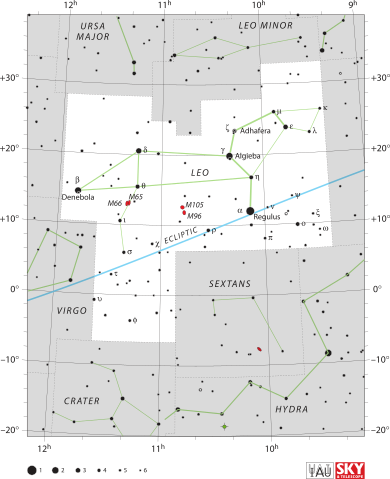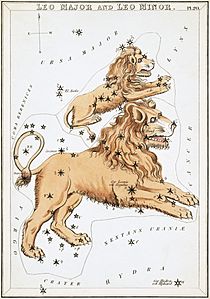Leo (constellation) facts for kids
| Constellation | |

List of stars in Leo
|
|
| Abbreviation | Leo |
|---|---|
| Genitive | Leonis |
| Pronunciation | genitive |
| Symbolism | the Lion |
| Right ascension | 11 |
| Declination | +15 |
| Quadrant | NQ2 |
| Area | 947 sq. deg. (12th) |
| Main stars | 9, 15 |
| Bayer/Flamsteed stars |
92 |
| Stars with planets | 11 |
| Stars brighter than 3.00m | 5 |
| Stars within 10.00 pc (32.62 ly) | 5 |
| Brightest star | Regulus (α Leo) (1.35m) |
| Messier objects | 5 |
| Meteor showers | Leonids |
| Bordering constellations |
Ursa Major Leo Minor Lynx (corner) Cancer Hydra Sextans Crater Virgo Coma Berenices |
| Visible at latitudes between +90° and −65°. Best visible at 21:00 (9 p.m.) during the month of April. |
|
Leo is a famous group of stars, also known as a constellation, that is part of the zodiac. Its name means 'lion' in Latin. The symbol for Leo is ![]() ( ♌). You can find Leo in the night sky between the constellations Cancer (to its west) and Virgo (to its east).
( ♌). You can find Leo in the night sky between the constellations Cancer (to its west) and Virgo (to its east).
Contents
Bright Stars in Leo
The Leo constellation has many bright and interesting stars.
Main Stars of Leo
- Regulus (also called Alpha Leonis) is the brightest star in Leo. It is often seen as the lion's heart.
- Denebola (also called Beta Leonis) marks the lion's tail.
- Algieba (also called Gamma-1 Leonis) is another bright star.
Other stars in Leo include:
- Zosma (Delta Leo)
- Chort (Theta Leo)
- Al Minliar al Asad (Kappa Leo)
- Alterf (Lambda Leo)
- Subra (Omicron Leo)
The Sickle Star Pattern
Several stars in Leo form a pattern called "the Sickle." This group of stars looks like a backwards question mark or a sickle tool. These stars represent the head and the flowing mane of the lion.
The stars that make up the Sickle are:
- Regulus
- Al Jabbah
- Algieba
- Adhafera
- Ras Elased Borealis
- Ras Elased Australis
Stars Close to Earth
The star Wolf 359 is located in Leo. It is one of the closest stars to Earth, about 7.78 light-years away.
Another interesting star is CW Leo (IRC +10216). This is a carbon star, which means it has a lot of carbon in its atmosphere. It is the brightest star in the night sky when observed using infrared light.
Deep Sky Objects in Leo
Leo is home to many amazing objects that are far beyond our solar system. These are called "deep sky objects."
Galaxies in Leo
Many bright galaxies can be found in the Leo constellation. Some of the most famous ones include:
- Messier 65
- Messier 66
- Messier 95
- Messier 96
- Messier 105
- NGC 3521
- NGC 3628
Messier 65 and Messier 66 are part of a group called the Leo Triplet. This is a famous group of three interacting spiral galaxies.
The Leo Ring
The Leo Ring is a huge cloud made of hydrogen and helium gas. It orbits around two galaxies that are found within the Leo constellation. Scientists are still studying how this ring formed.
The Story of Leo: Name and History
For thousands of years, many different cultures have seen the constellation Leo as a lion.
Ancient Egyptian Beliefs
One idea about why Leo is a lion is connected to ancient Egypt. The Sun used to be among Leo's stars during Midsummer. This was the time when lions in the Egyptian desert would go to the banks of the Nile River. They went there to find relief from the summer heat in the water.
The Roman writer Pliny the Elder wrote that the Egyptians honored the stars of Leo. He said this was because the Nile River would flood at the same time the Sun entered the Leo constellation. This flooding was very important for farming in Egypt.
The Ramesseum, a temple in Thebes, Egypt, has an inscription on its wall that mentions Leo. On the planisphere of Dendera, an ancient Egyptian star map, Leo is shown standing on a stretched-out serpent.
Names from Other Cultures
Many ancient civilizations had names for this constellation that meant "lion":
- The Persians called it Ser or Shir.
- The Turks called it Artan.
- The Syrians called it Aryo.
- The Jewish people called it Arye.
- The Indians called it Simha.
In Babylonian astronomy, these stars were known as UR.GU.LA, which means 'Great Lion'. The bright star Regulus, located at the lion's chest, was known as the 'King Star' because of its royal connection.
Greek and Roman Mythology
In Greek mythology, Leo was identified as the Nemean Lion. This was a fierce beast that the hero Hercules had to kill as one of his twelve difficult tasks. After Hercules defeated it, the lion was placed in the sky as a constellation.
The Roman poet Ovid called it Herculeus Leo (Hercules' Lion) and Violentus Leo (Violent Lion). Another name for it was Bacchi Sidus (Star of Bacchus), because the god Bacchus was often linked with lions. However, Manilius called it Jovis et Junonis Sidus (Star of Jupiter and Juno).
Early Hindu Astronomy
Early Hindu astronomers knew Leo as Asleha and as Sinha. In the Tamil language, it was called Simham.
Astrology and Leo
Astrology is a belief system that connects the positions of stars and planets to events on Earth and people's lives.
As of 2002, the Sun appeared in the actual constellation Leo from August 10 to September 15. In tropical astrology, the Sun is thought to be in the sign Leo from July 23 to August 22. In sidereal astrology, the sun is said to be in Leo from August 16 to September 15.
How to See Leo: Visualizations
Astronomer H.A. Rey suggested a different way to connect the stars of Leo. This way makes the constellation look like a walking lion.
- The stars delta Leonis, gamma Leonis, eta Leonis, and theta Leonis form the lion's body.
- The stars gamma Leonis, zeta Leonis, mu Leonis, epsilon Leonis, and eta Leonis form the lion's neck.
- The stars mu Leonis, kappa Leonis, lambda Leonis, and epsilon Leonis form the lion's head.
- Delta Leonis and beta Leonis form the lion's tail. Beta Leonis, also known as Denebola, is the bright tip of the tail.
- The stars theta Leonis, iota Leonis, and sigma Leonis form the left back leg of the lion, with sigma Leonis as the foot.
- The stars theta Leonis and rho Leonis form the right back leg, with rho Leonis as the foot.
- The stars eta Leonis and alpha Leonis mark the lion's heart. Alpha Leonis, also known as Regulus, is a very bright star.
- The stars eta Leonis and omicron Leonis form the right front foot of the lion.
Images for kids
-
The notable gravitational lens known as the Cosmic Horseshoe is found in Leo.
See also
 In Spanish: Leo (constelación) para niños
In Spanish: Leo (constelación) para niños





